JavaScript is disabled for your browser. Some features of this site may not work without it.
Buscar en RiuNet
Listar
Mi cuenta
Estadísticas
Ayuda RiuNet
Admin. UPV
Influence of lattice stability on hydrothermal deactivation of Cu-ZSM-5 and Cu-IM-5 zeolites for selective catalytic reduction of NOx by NH3
Mostrar el registro sencillo del ítem
Ficheros en el ítem
| dc.contributor.author | VENNESTROM, PETER NICOLAI RAVNBORG
|
es_ES |
| dc.contributor.author | Janssens, Ton V. W.
|
es_ES |
| dc.contributor.author | Kustov, Arkady
|
es_ES |
| dc.contributor.author | Grill, Marie
|
es_ES |
| dc.contributor.author | Puig-Molina, Anna
|
es_ES |
| dc.contributor.author | Lundegaard, Lars F.
|
es_ES |
| dc.contributor.author | Tiruvalam, Ramchandra R.
|
es_ES |
| dc.contributor.author | Concepción Heydorn, Patricia
|
es_ES |
| dc.contributor.author | Corma Canós, Avelino
|
es_ES |
| dc.date.accessioned | 2016-04-12T09:34:53Z | |
| dc.date.available | 2016-04-12T09:34:53Z | |
| dc.date.issued | 2014-01 | |
| dc.identifier.issn | 0021-9517 | |
| dc.identifier.uri | http://hdl.handle.net/10251/62443 | |
| dc.description.abstract | Copper-exchanged zeolites are well-known catalysts for the selective catalytic reduction of nitrogen oxides by ammonia (NH3-SCR). To determine the influence of framework stability on catalyst deactivation, two zeolite frameworks, MFI and IMF, were used in this study. The two frameworks have similar window size and connectivities, but the IMF structure is less susceptible towards dealumination. In each zeolite, copper was introduced by aqueous exchange and the catalytic performance in the NH3-SCR reaction compared before and after hydrothermal ageing at 650 and 750 C. The changes in state and local environment of Cu and the degradation of the zeolite structure were characterized using ammonia capacity measurements, solid state nuclear magnetic resonance, X-ray fine structure spectroscopy, temperature programmed reduction with hydrogen, infrared spectroscopy monitoring of adsorbed NO and CO probe molecules as well as the combination of transmission electron microscopy and energy dispersive X-ray spectroscopy to follow copper migration. The catalytic performance of Cu-ZSM-5 and Cu-IM-5 is similar in the fresh state, but after hydrothermal ageing the deactivation of Cu-IM-5 is less severe compared to Cu-ZSM-5 as a consequence of the higher framework stability. The changes in catalyst structure that occur during ageing are (i) partial dealumination of the zeolite, (ii) reversible migration of copper species, and (iii) irreversible formation of catalytically inactive and stable Cu Al clusters, which have some resemblance to CuAl2O4, but without the symmetry of Cu in the spinel structure. As the Cu Al clusters only form once Al is detached from the framework, the stability of Al in the zeolite framework is proposed to dictate the overall hydrothermal deactivation behaviour of Cu-ZSM-5 and Cu-IM-5 in the NH3-SCR reaction. | es_ES |
| dc.description.sponsorship | The authors thank Fernando Morales for introduction to the EXAFS software and Kenneth Malmstrom Larsen, Robin Christensen and Katarina Noren for their assistance during the experiments at the synchrotron facilities. We also gratefully acknowledge DANSCATT for their financial support, and Hasylab and MAXlab for offering beamtime at the ROMO II and 1811 beamlines, respectively. Finally, we thank the Danish Ministry of Science, Innovation and Higher Education for support through the Industrial PhD programme. | en_EN |
| dc.language | Inglés | es_ES |
| dc.publisher | Elsevier | es_ES |
| dc.relation.ispartof | Journal of Catalysis | es_ES |
| dc.rights | Reserva de todos los derechos | es_ES |
| dc.subject | NH3-SCR | es_ES |
| dc.subject | Copper migration | es_ES |
| dc.subject | Cu-IM-5 | es_ES |
| dc.subject | Cu-ZSM-5 | es_ES |
| dc.subject | Dealumination | es_ES |
| dc.subject | Framework stability | es_ES |
| dc.subject | Hydrothermal deactivation | es_ES |
| dc.subject | Mechanism | es_ES |
| dc.subject | Selective catalytic reduction | es_ES |
| dc.subject | Zeolites | es_ES |
| dc.subject.classification | QUIMICA ORGANICA | es_ES |
| dc.title | Influence of lattice stability on hydrothermal deactivation of Cu-ZSM-5 and Cu-IM-5 zeolites for selective catalytic reduction of NOx by NH3 | es_ES |
| dc.type | Artículo | es_ES |
| dc.identifier.doi | 10.1016/j.jcat.2013.10.017 | |
| dc.rights.accessRights | Abierto | es_ES |
| dc.contributor.affiliation | Universitat Politècnica de València. Departamento de Química - Departament de Química | es_ES |
| dc.contributor.affiliation | Universitat Politècnica de València. Instituto Universitario Mixto de Tecnología Química - Institut Universitari Mixt de Tecnologia Química | es_ES |
| dc.description.bibliographicCitation | Vennestrom, PNR.; Janssens, TVW.; Kustov, A.; Grill, M.; Puig-Molina, A.; Lundegaard, LF.; Tiruvalam, RR.... (2014). Influence of lattice stability on hydrothermal deactivation of Cu-ZSM-5 and Cu-IM-5 zeolites for selective catalytic reduction of NOx by NH3. Journal of Catalysis. 309:477-490. https://doi.org/10.1016/j.jcat.2013.10.017 | es_ES |
| dc.description.accrualMethod | S | es_ES |
| dc.relation.publisherversion | http://dx.doi.org/10.1016/j.jcat.2013.10.017 | es_ES |
| dc.description.upvformatpinicio | 477 | es_ES |
| dc.description.upvformatpfin | 490 | es_ES |
| dc.type.version | info:eu-repo/semantics/publishedVersion | es_ES |
| dc.description.volume | 309 | es_ES |
| dc.relation.senia | 280874 | es_ES |
| dc.identifier.eissn | 1090-2694 | |
| dc.contributor.funder | DanScatt | |
| dc.contributor.funder | Ministry of Science, Innovation and Higher Education, Dinamarca |







![[Cerrado]](/themes/UPV/images/candado.png)

